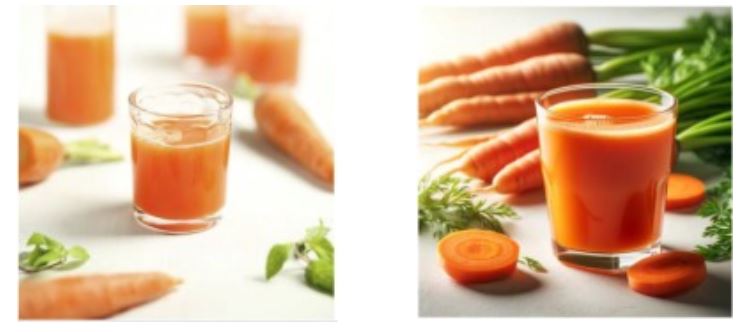
University of Naples Federico II, University of Oxford
With the Global Nutrition and Hydration Week 2024 starting today, researchers have announced an intriguing discovery – consumers generally prefer AI-generated images of food over real food images, especially when they are unaware of their true nature. The new findings have been published in Food Quality and Preference.
According to the researchers, the results suggest that AI-generated food visuals excel at enhancing the appeal of depicted foods by leveraging key features such as symmetry, shape, glossiness, and overall lighting and colour. All of these are known to contribute significantly to the attractiveness of food imagery.
Even subtle tweaks in positioning may enhance the appeal of AI-generated food images. Lead author Giovanbattista Califano (Department of Agricultural Sciences, University of Naples Federico II) explained: ‘As humans, we tend to feel uneasy with objects pointing towards us, interpreting them as threats, even when it’s just food. When tasked with replicating food photos featuring items pointing at the viewer, such as a bunch of carrots or a piece of cake, the AI often positions the food so that it doesn’t directly point at the viewer. This warrants further studies, but it's plausible that this approach enhances the perceived attractiveness of the depicted food.’
In the study, the researchers asked 297 participants to rate real or AI-generated food images on a scale from “Not at all appetizing” to “Extremely appetizing.” The images depicted a range of natural, processed, and ultra-processed foods, from apples and carrots to chocolate milkshakes and potato fries. When participants were told how each image had been created—whether through photography or AI—they tended to rate real and AI-generated versions equally appealing. However, when participants were unaware of the image creation process, the AI-generated version was consistently rated as significantly more appetizing than the real food image.
Study supervisor and co-author Professor Charles Spence (Department of Experimental Psychology, University of Oxford) said: ‘While AI-generated visuals may offer cost-saving opportunities for marketers and the industry by reducing the cost of commissioning food photoshoots, these findings highlight potential risks associated with exacerbating ‘visual hunger’ amongst consumers—the phenomenon where viewing images of food triggers appetite and cravings. This could potentially influence unhealthy eating behaviours or foster unrealistic expectations about food among consumers.’
Additionally, the researchers also found that AI-generated images tend to depict foods to appear more energy-dense compared to the originals, particularly in the abundance portrayed. For instance, AI may increase the number of fries in the image or add more whipped cream to a dessert. Given that humans have an evolutionary drive to pay more attention to energy-dense foods, this raises concerns that widespread dissemination of such idealized food images could promote cue-induced eating of unhealthy foods.
Furthermore, with the global movement towards more sustainable consumption patterns, including the promotion of ‘ugly’ fruits and vegetables, there is a concern that constant production of AI-enhanced food images might nudge consumers towards an unrealistic standard of how natural foods should look, potentially harming sustainability efforts.

This article, “Assessing the visual appeal of real/AI-generated food images”, by Giovanbattista Califano and Charles Spence, has been published online in Food Quality and Preference: https://doi.org/10.1016/j.foodqual.2024.105149
Images: The AI-generated and real food images used in the study are accessible in Appendix A. Supplementary data through the following link: https://doi.org/10.1016/j.foodqual.2024.105149
For media enquiries and interview requests contact:
Giovanbattista Califano (giovanbattista.califano@unina.it) Charles Spence (charles.spence@psy.ox.ac.uk)
About the University of Naples Federico II (www.unina.it)
The University of Naples Federico II is a public research university in Naples, Campania, Italy. Established in 1224 and named after its founder, Frederick II, it is the oldest public, secular, non-sectarian or state-funded university in the world, and one of the world’s ten oldest universities in continuous operation.
In 2024, the University of Naples Federico II proudly celebrates its 800th anniversary, marking eight centuries of academic excellence, innovation, and cultural impact. With over 90,000 students in 2022 it is among the largest universities in Europe.
Among those who have attended the University of Naples Federico II are Italian presidents Enrico De Nicola, Giovanni Leone and Giorgio Napolitano; philosophers Giordano Bruno, Benedetto Croce and Nicola Abbagnano; astronaut and commander of the International Space Station Samantha Cristoforetti.
About the University of Oxford (www.ox.ac.uk)
Oxford University has been placed number 1 in the Times Higher Education World University Rankings for the eighth year running, and number 3 in the QS World Rankings 2024. At the heart of this success are the twin pillars of our ground-breaking research and innovation and our distinctive educational offer.
Oxford is world-famous for research and teaching excellence and is home to some of the most talented people from across the globe. Our work helps the lives of millions, solving real-world problems through a huge network of partnerships and collaborations. The breadth and interdisciplinary nature of our research alongside our personalised approach to teaching sparks imaginative and inventive insights and solutions.
Through its research commercialisation arm, Oxford University Innovation, Oxford is the highest university patent filer in the UK and is ranked first in the UK for university spinouts, having created more than 300 new companies since 1988. Over a third of these companies have been created in the last five years. The university is a catalyst for prosperity in Oxfordshire and the United Kingdom, contributing £15.7 billion to the UK economy in 2018/19, and supports more than 28,000 full-time jobs.



